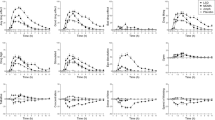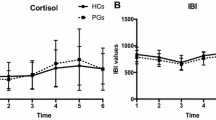Abstract
Despite its formal definition as a disorder of impulse control, pathological gambling has come under the generic label of addictive disorders with subjective excitement and physiological arousal as the major motivating factor. Individual differences in autonomic/cortical arousability in interaction with irregular schedules of reinforcement have been postulated to be important determinant factors in the pathogenesis of pathological gambling (Anderson & Brown, 1984). Mood disturbances and cross-addictions are frequently observed in pathological gamblers seeking treatment and the behavior has also been conceptualized as a defense against depression and anxiety. Recently the role of endorphins has been implicated in mood disturbances associated with psychiatric states and in addictive processes; the latter through their euphorogenic or reward-transmitting properties in accordance with operant and classical conditioning principles. The hypothesis that the etiology or maintenance of gambling behavior is related to endorphin activity was investigated in this study. Using radioimmunoassay techniques, baseline B-endorphin plasma levels were measured in a sample of 39 pathological gamblers seeking treatment and 16 male and 19 female non-gambling healthy control subjects. In addition, B-endorphin reactivity to gambling activity was measured in a subgroup of 13 horse-race gamblers.
Diagnostic and Statistical Manual III criteria for diagnosis were used. Written consent was obtained. Blood samples were drawn at the same time of day for each subject. The experimental procedure consisted of taking baseline blood samples at 11 a.m. following which subjects were instructed to place a bet sufficient to “excite” them on a horse-race. A subsequent blood sample was taken at 2 p.m., five minutes after subjects listened to the race broadcast on radio. Heart rate measures and a visual analogue scale rating excitement, tension and urge to gamble were also administered immediately before and after the race broadcast. Results showed that as a group pathological gamblers did not differ from controls on baseline B-endorphin levels. But differentiating gamblers according to type of gambling activity revealed horserace addicts to have significantly lower baseline levels as compared to poker-machine players and controls. This finding provides empirical evidence for the hypothesis that distinct subgroups of gamblers exist and raises the corollary that different etiological factors may characterize each subgroup. That B-endorphin levels did not increase in response to gambling was explained by the failure of the relatively small bet size to generate high arousal.
Similar content being viewed by others
References
Anderson, G., Brown, R. (1984). Real and Laboratory Gambling, Sensation seeking and arousal.The British Journal of Psychology, 75(3), 401–410.
Belluzzi, J.D., Stein, L. (1977). Enkephalin may mediate euphoria and drive reduction reward.Nature, 266 556–558.
Blaszczynski, A.P., Buhrich, N., McConaghy, N. (1985). Pathological gamblers, heroin addicts and controls compared on the E.P.Q. “Addiction Scale’.British Journal of Addiction, (in press).
Blaszczynski, A.P., Winter, S.W. (1984). Endorphins and psychiatry. Editorial Comment,Australian and New Zealand Journal of Psychiatry, 18 111–112.
Blaszczynski, A.P. (1983).Pathological gambling: A neglected problem. Paper presented at the 4th Congress on Psychiatry, Psychology and Law, Melbourne.
Blum, K., Hamilton, M.G., Hirst, M. (1978). Putative role of isoquinoline alkaloids in alcoholism: A link to opiates.Alcoholism of Clinical & Experimental Research 2 113–120.
Brown, R.I.F. (1984).The integration of arousal and sensation seeking factors in the explanation of gambling and gambling addictions. Paper presented at the 6th Conference on Gambling and Risk Taking, Atlantic City, New Jersey, December.
Davis, V.E., Walsh, M.J. (1970). Alcohol, amines and alkaloids: A possible basis for alcohol addiction.Science, 167 1005–1007.
Dickerson, M.G. (1984).Compulsive Gambling. Longmans, Sydney.
Ferrioloi, M., Ciminero, A.R. (1981). The treatment of pathological gambling as an addictive behavior. In W.R. Eadington, (ed.)The Gambling Papers: Proceedings of the Fifth National Conference on Gambling and Risk Taking. Bureau of Business and Economic Research, University of Nevada, Reno.
Gerner, R.H., Catlin, D.H., Gorelick, D.A., Hui, K.K., Li, C.H. (1980). B-endorphin: Intravenous infusion causes behavioral change.Archives of General Psychiatry, 37 642–647.
Goldstein, A. (1976). Opioid peptides endorphins in pituitary and brain.Science, 193 1081–1086.
Hughes, J. (1976). Enkephalin and drug dependence.British Journal of Addiction, 71 199–209.
Jacobs, D.F., Pettis, J.L., Linda, L. (1981). The addictive personality syndrome: A new theoretical model for understanding and treating addictions. In W. R. Eadington, (ed.)The Gambling Papers: Proceedings of the Fifth National Conference on Cambling and Risk Taking. Bureau of Business and Economic Research, University of Nevada, Reno.
Leary, K., Dickerson, M.G. (1984). Levels of Arousal in High- and Low-Frequency Gamblers. Unpublished manuscript.
Lesieur, H.R. (1979). The compulsive gambler's spiral of options and involvement.Psychiatry, 42(1), 79–87.
McConaghy, N. (1980). Behavioral completion mechanisms rather than primary drives maintain behavioral patterns.Activas Nervosa Superior (Praha),22 138–151.
McConaghy, N., Armstrong, M.S., Blaszczynski, A., Allcock, C. (1983). Controlled comparison of aversive therapy and imaginal desensitization in compulsive gambling.British Journal of Psychiatry, 142 366–372.
McCormick, R.A., Russo, A.M., Ramirez, L.F., Taber, J.I. (1984). Affective Disorders among pathological gamblers seeking treatment.American Journal of Psychiatry, 141(2), 215–218.
Moran, E. (1970). Gambling as a form of dependence.British Journal of Addictions, 64 419–428.
Moskowitz, J. (1980). Lithium and Lady Luck.New York State Journal of Medicine, 80 785–788.
Pratt, M., Maltzman, I., Hauprich, W., Ziskind, E. (1982). Electrodermal activity of sociopaths and controls in the cold pressor test.Psychophysiology, 19 342.
Skinner, B.F. (1953).Science and Human Behavior. Macmillan, New York.
Snyder, S. (1975). Opiate receptors in normal and drug altered brain functions.Nature, 257 185–189.
Spitzer, R.L. (1980).Diagnostic and Statistical Manual of Mental Disorders.Third Edition. American Psychiatric Association, Washington, D.C.
Sullivan, J. L. (1985). Personal communication.
Tec, N. (1964).Gambling in Sweden. Bedminster Press, Towana, N.J.
Van Ree, J.M. (1983). Neuropeptides and addictive behavior.Alcohol and Alcoholism, 18 325–330.
Van Ree, J.M., DeWied, D., Bradbury, A.F., Hulme, E.C., Smyth, D.G., Snell, C.R. (1976). Induction of tolerance to the analgesic action of lipotropin c-fragment.Nature, 264 792–794.
Wray, I., Dickerson, M.G. (1981). Cessation of high frequency gambling and ‘withdrawal’ symptoms.British Journal of Addictions, 76 401–405.
Zuckerman, M. (1979).Sensation Seeking: Beyond the Optimum Level of Arousal. Hillsdale, New Jersey.
Author information
Authors and Affiliations
Rights and permissions
About this article
Cite this article
Blaszczynski, A.P., Winter, S.W. & McConaghy, N. Plasma endorphin levels in pathological gambling. J Gambling Stud 2, 3–14 (1986). https://doi.org/10.1007/BF01019930
Issue Date:
DOI: https://doi.org/10.1007/BF01019930




